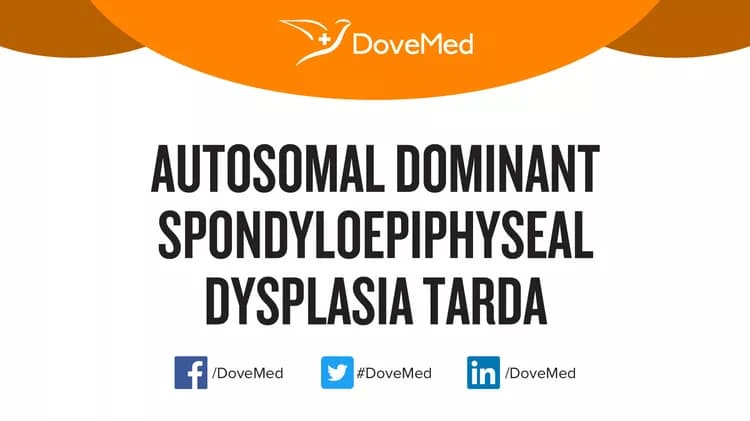
Autosomal Dominant Spondyloepiphyseal Dysplasia Tarda
What are the other Names for this Condition? (Also known as/Synonyms)
- Autosomal dominant SEDT
What is Autosomal Dominant Spondyloepiphyseal Dysplasia Tarda? (Definition/Background Information)
- Autosomal Dominant Spondyloepiphyseal Dysplasia Tarda (Autosomal Dominant SEDT) is an inherited condition that affects bone growth
- Signs and symptoms are generally physically apparent by puberty; however, abnormalities may be seen on X-ray at an earlier age
- Affected people may have skeletal abnormalities, short stature (with a short neck and trunk, specifically), scoliosis, kyphosis, lumbar hyperlordosis (exaggerated curvature of the lower back), and early-onset progressive osteoarthritis of the hips and knees
- Some cases of Autosomal Dominant SEDT may be caused by changes (mutations) in the COL2A1 gene. As the name suggests, the condition is inherited in an autosomal dominant manner
- Treatment is based on the signs and symptoms present in each person and may include surgery and pain management strategies
(Source: Autosomal Dominant Spondyloepiphyseal Dysplasia Tarda; Genetic and Rare Diseases Information Center (GARD) of National Center for Advancing Translational Sciences (NCATS), USA.)
Who gets Autosomal Dominant Spondyloepiphyseal Dysplasia Tarda? (Age and Sex Distribution)
- Autosomal Dominant Spondyloepiphyseal Dysplasia Tarda is a rare congenital disorder. The presentation of symptoms may become apparent during puberty
- Both males and females may be affected
- Worldwide, individuals of all racial and ethnic groups may be affected
What are the Risk Factors for Autosomal Dominant Spondyloepiphyseal Dysplasia Tarda? (Predisposing Factors)
- A positive family history may be an important risk factor, since Autosomal Dominant Spondyloepiphyseal Dysplasia Tarda can be inherited
- Currently, no other risk factors have been clearly identified for Autosomal Dominant SEDT
It is important to note that having a risk factor does not mean that one will get the condition. A risk factor increases one’s chances of getting a condition compared to an individual without the risk factors. Some risk factors are more important than others.
Also, not having a risk factor does not mean that an individual will not get the condition. It is always important to discuss the effect of risk factors with your healthcare provider.
What are the Causes of Autosomal Dominant Spondyloepiphyseal Dysplasia Tarda? (Etiology)
- Autosomal Dominant Spondyloepiphyseal Dysplasia Tarda may be caused by changes (mutations) in the COL2A1 gene
- The condition is reportedly inherited in an autosomal dominant manner
Autosomal dominant: Autosomal dominant conditions are traits or disorders that are present when only one copy of the mutation is inherited on a non-sex chromosome. In these types of conditions, the individual has one normal copy and one mutant copy of the gene. The abnormal gene dominates, masking the effects of the correctly function gene. If an individual has an autosomal dominant condition, the chance of passing the abnormal gene on to their offspring is 50%. Children, who do not inherit the abnormal gene, will not develop the condition or pass it on to their offspring.
What are the Signs and Symptoms of Autosomal Dominant Spondyloepiphyseal Dysplasia Tarda?
The signs and symptoms of Autosomal Dominant Spondyloepiphyseal Dysplasia Tarda may include:
- Abnormality of epiphysis morphology
- Arthralgia
- Barrel-shaped chest
- Disproportionate short stature
- Platyspondyly
- Short thorax
- Spondyloepiphyseal dysplasia
- Thoracic kyphosis
- Upper limb undergrowth
- Coxa vara
- Hip osteoarthritis
- Hypoplasia of the odontoid process
- Hypoplastic iliac wing
- Lumbar hyperlordosis
- Short neck
- Arthritis
- Avascular necrosis of the capital femoral epiphysis
- Childhood-onset short-trunk short stature
- Irregular vertebral endplates
- Kyphoscoliosis
- Malar flattening
- Pectus carinatum
(Source: Autosomal Dominant Spondyloepiphyseal Dysplasia Tarda; Genetic and Rare Diseases Information Center (GARD) of National Center for Advancing Translational Sciences (NCATS), USA.)
How is Autosomal Dominant Spondyloepiphyseal Dysplasia Tarda Diagnosed?
Autosomal Dominant Spondyloepiphyseal Dysplasia Tarda is diagnosed on the basis of the following information:
- Complete physical examination
- Thorough medical history evaluation
- Assessment of signs and symptoms
- Laboratory tests
- Imaging studies, such as X-rays for detecting skeletal abnormalities
- Biopsy studies, if necessary
Many clinical conditions may have similar signs and symptoms. Your healthcare provider may perform additional tests to rule out other clinical conditions to arrive at a definitive diagnosis.
What are the possible Complications of Autosomal Dominant Spondyloepiphyseal Dysplasia Tarda?
The complications of Autosomal Dominant Spondyloepiphyseal Dysplasia Tarda may include:
- Severe pain due to arthritis
- Lung damage due to scoliosis as a result of the rib cage pressing against the lungs and affecting its normal function, causing breathing difficulties. This may also lead to lung infections (pneumonia)
- Heart damage: As a result of scoliosis, the rib cage presses against the chest causing damage to the heart, leading to its malfunction
- Back problems: Severe back pain is an end result of scoliosis
- Low self-esteem due to short stature
Complications may occur with or without treatment, and in some cases, due to treatment also.
How is Autosomal Dominant Spondyloepiphyseal Dysplasia Tarda Treated?
There is no cure for Autosomal Dominant Spondyloepiphyseal Dysplasia Tarda, since it is a genetic condition. The treatment is usually given to manage the signs and symptoms and any complication that develops.
How can Autosomal Dominant Spondyloepiphyseal Dysplasia Tarda be Prevented?
Autosomal Dominant Spondyloepiphyseal Dysplasia Tarda may not be preventable, since it is a genetic disorder.
- Genetic testing of the expecting parents (and related family members) and prenatal diagnosis (molecular testing of the fetus during pregnancy) may help in understanding the risks better during pregnancy
- If there is a family history of the condition, then genetic counseling will help assess risks, before planning for a child
- Active research is currently being performed to explore the possibilities for treatment and prevention of inherited and acquired genetic disorders
- Regular medical screening at periodic intervals with tests and physical examinations are recommended
What is the Prognosis of Autosomal Dominant Spondyloepiphyseal Dysplasia Tarda? (Outcomes/Resolutions)
- The prognosis of Autosomal Dominant Spondyloepiphyseal Dysplasia Tarda is dependent upon the severity of the signs and symptoms and associated complications, if any
- Individuals with mild conditions have better prognosis than those with severe symptoms and complications
- Typically, the prognosis may be assessed on a case-by-case basis
Additional and Relevant Useful Information for Autosomal Dominant Spondyloepiphyseal Dysplasia Tarda:
The following DoveMed website link is a useful resource for additional information:
Related Articles
Test Your Knowledge
Asked by users
Related Centers
Related Specialties
Related Physicians
Related Procedures
Related Resources
Join DoveHubs
and connect with fellow professionals

0 Comments
Please log in to post a comment.